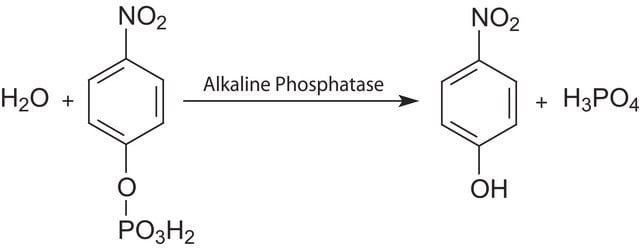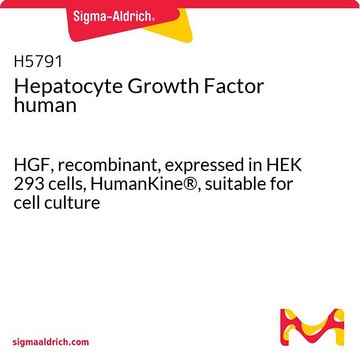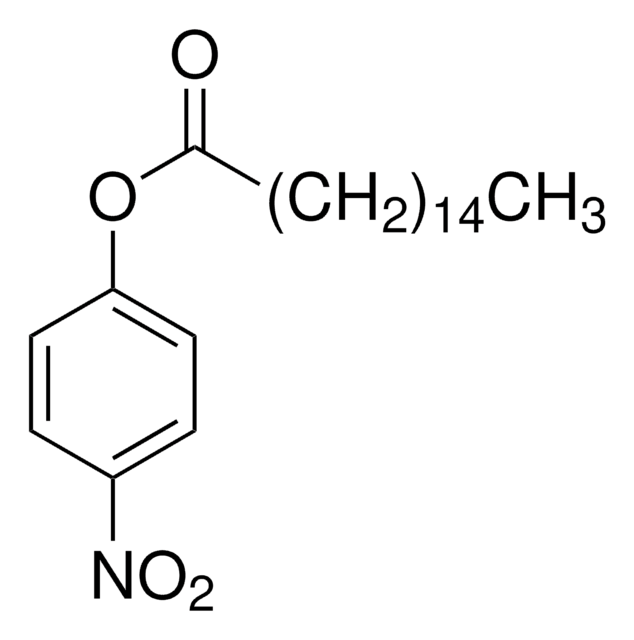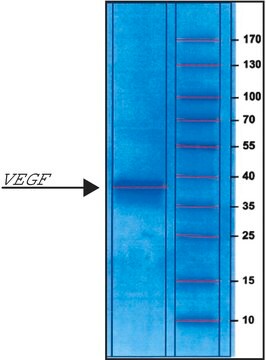O1637
Oncostatin M from mouse
BioReagent, ≥97% (SDS-PAGE), recombinant, expressed in E. coli, lyophilized powder, suitable for cell culture
Synonyme(s) :
OSM
Se connecterpour consulter vos tarifs contractuels et ceux de votre entreprise/organisme
About This Item
Produits recommandés
Source biologique
mouse
Niveau de qualité
Produit recombinant
expressed in E. coli
Gamme de produits
BioReagent
Essai
≥97% (SDS-PAGE)
Forme
lyophilized powder
Puissance
0.25-1 ng/mL EC50
Poids mol.
21 kDa
Conditionnement
pkg of 25 μg
Technique(s)
cell culture | mammalian: suitable
Impuretés
endotoxin, tested
Numéro d'accès UniProt
Température de stockage
−20°C
Informations sur le gène
mouse ... Osm(18413)
Application
Oncostatin M from mouse has been used in the preparation of culture medium for primary culture of mouse fetal hepatoblasts (MFHs).
Actions biochimiques/physiologiques
Oncostatin M, LIF, G-CSF, IL-6, and ciliary neurotrophic factor (CNTF) are structurally related members of the same cytokine family sharing similarities in their primary amino acid sequences, predicted secondary structure, and receptor components. Oncostatin M is a growth-regulating cytokine, affecting a number of tumor and normal cells. This material was first identified by its ability to inhibit the growth of A375 melanoma cells and other human tumor cells, but not inhibit the growth of normal human fibroblasts. It acts synergistically with TGF β1 to inhibit the proliferation of tumor cells like A375 melanoma cells. It induces an increase in LDL receptor expression and LDL uptake by hepatoma cells. OSM activates synovial fibroblast-like cells to produce urokinase type plasminogen activator. Oncostatin M is secreted by macrophages and activated T lymphocytes.
Forme physique
Lyophilized from a 0.2 μm filtered solution in phosphate buffered saline containing 1.25 mg bovine serum albumin.
Remarque sur l'analyse
The biological activity of recombinant mouse OSM was measured by its ability to stimulate 3H-thymidine incorporation in quiescent NIH/3T3 cells.
Code de la classe de stockage
11 - Combustible Solids
Classe de danger pour l'eau (WGK)
WGK 3
Point d'éclair (°F)
Not applicable
Point d'éclair (°C)
Not applicable
Équipement de protection individuelle
Eyeshields, Gloves, type N95 (US)
Faites votre choix parmi les versions les plus récentes :
Déjà en possession de ce produit ?
Retrouvez la documentation relative aux produits que vous avez récemment achetés dans la Bibliothèque de documents.
Tadasuke Komori et al.
Diabetologia, 58(8), 1868-1876 (2015-05-15)
Obesity and insulin resistance are closely associated with adipose tissue dysfunction caused by the abnormal recruitment of inflammatory cells, including macrophages. Oncostatin M (OSM), a member of the IL-6 family of cytokines, plays important roles in a variety of biological
Yuxin Wang et al.
Proceedings of the National Academy of Sciences of the United States of America, 110(42), 16975-16980 (2013-10-02)
The activation of STAT3 by tyrosine phosphorylation, essential for normal development and for a normal inflammatory response to invading pathogens, is kept in check by negative regulators. Abnormal constitutive activation of STAT3, which contributes to the pathology of cancer and
N Kanda et al.
Allergy, 67(6), 804-812 (2012-04-11)
Skin lesions with atopic dermatitis (AD) are associated with dysregulated expression of LL-37 and enhanced expression of IL-22, thymic stromal lymphopoietin (TSLP), IL-25, IL-31, and oncostatin M. Vitamin D3 enhances LL-37 production in keratinocytes. This study aimed to examine the
Andrea Rinaldi et al.
British journal of haematology, 163(2), 194-204 (2013-08-22)
In a fraction of patients, chronic lymphocytic leukaemia (CLL) can transform to Richter syndrome (RS), usually a diffuse large B-cell lymphoma (DLBCL). We studied genome-wide promoter DNA methylation in RS and clonally related CLL-phases of transformed patients, alongside de novo
Vicky Nicolaidou et al.
PloS one, 7(7), e39871-e39871 (2012-07-18)
A major therapeutic challenge is how to replace bone once it is lost. Bone loss is a characteristic of chronic inflammatory and degenerative diseases such as rheumatoid arthritis and osteoporosis. Cells and cytokines of the immune system are known to
Notre équipe de scientifiques dispose d'une expérience dans tous les secteurs de la recherche, notamment en sciences de la vie, science des matériaux, synthèse chimique, chromatographie, analyse et dans de nombreux autres domaines..
Contacter notre Service technique







